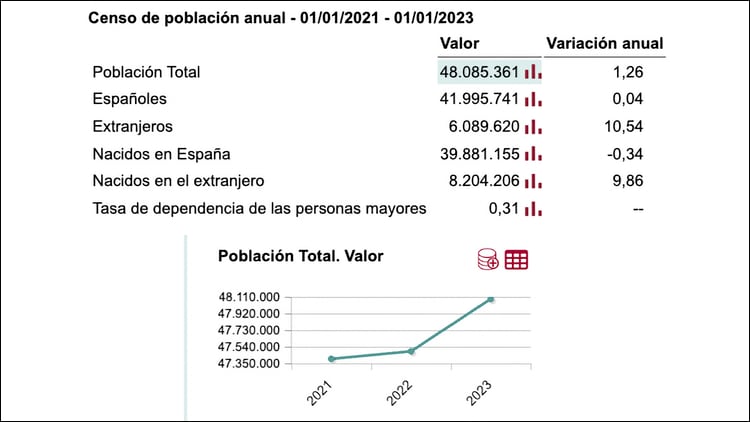The Diplomat
Spain’s population increased by 598,634 inhabitants during 2022 and exceeded 48 million (48,085,361 people) for the first time on 1 January 2023, according to the first results of the Population Census published by the National Statistics Institute (INE).
The increase was mainly due to foreigners, whose number grew by 580,574 people, to exceed six million for the first time (specifically, 6,089,620), reports Europa Press.
Thus, the resident population in Spain on 1 January 2023 increased by 1.26% compared to the same dates in 2022 (when it reached 47,486,727 inhabitants). Of this year’s total, 41,995,741 were of Spanish nationality (87.3%) and 6,089,620 were of foreign nationality (12.7%), which meant 10.5% more foreigners than the previous year. Of the population, 82.9% was born in Spain and 17.1% abroad.
In the case of foreigners, the number of foreigners in Spain has been increasing progressively in recent years since, on 1 January 2001, it stood at 1,572,013; this figure rose to 5,252,473 on 1 January 2011, and to 5,402,702 on 1 January 2021 in 2021. On the same date in 2022 the figure was 5,509,046 people, rising to 6,089,620 in 2023.
The most numerous foreigners in Spain on 1 January 2023 were from Morocco (893,953), Romania (629,755), Colombia (453,911), Italy (301,791), the United Kingdom (284,037) and Venezuela (278,159). Among the main nationalities, the largest population increases during 2022 were among citizens of Colombia (142,391 more), Ukraine (83,401 more) and Venezuela (64,498), and the largest decreases were among citizens of Romania (-9,742), the United Kingdom (-7,328) and Bulgaria (-3,061).
In relative terms, by nationality, the largest increases in foreign nationals during 2022 were among citizens of Ukraine (75.9%), Colombia (45.7%) and Peru (44.9%), compared with the decreases in Bulgaria (-2.6%), the United Kingdom (-2.5%) and Romania (-1.5%).
On 1 January 2023, 44.0% of the population resided in the same municipality in which they were born and 22.0% in another municipality in the same province. The percentage of foreign-born persons reached 17.1% (on the same date in 2022 it was 15.7%). Among those born abroad, 12.5% (more than one million) were born in Morocco, 8.7% in Colombia and 6.6% in Romania.
On the other hand, during the year 2022, the population of Spain increased in all the Autonomous Communities, except in Extremadura (where it decreased by 2,502 persons). The largest increases occurred in Catalonia (140,140 more people), Comunidad de Madrid (128,649 more) and Comunitat Valenciana (108,079 more). In relative terms, the largest population increases were in Comunitat Valenciana (2.1%), Baleares and Comunidad de Madrid (1.9% in both).
All but seven provinces saw their number of inhabitants increase over the last year. Those that grew the most were Alicante (2.5%), Guadalajara (2.5%) and Girona (2.3%), compared with the decreases recorded in the provinces of Jaén (-0.6%), Zamora (-0.6%) and Badajoz (-0.3%).
40.1% of the population resided in 2023 in municipalities with more than 100,000 inhabitants and 20.0% in municipalities with less than 10,000 inhabitants, while 3.0% of the population resided in municipalities with less than 1,000 inhabitants.
Torrevieja, Estepona and Benidorm, the cities with the highest growth rates
In 4,725 of the 8,131 municipalities existing on 1 January 2023 (41.9% of the total) the population increased or remained the same during 2022. Looking at the main cities, the largest population decreases during 2022 in relative terms occurred in Linares (Jaén, with -1.1%), Cádiz (-1.1%), Puertollano (Ciudad Real, with -0.8%), Coslada (Madrid, with -0.5%) and Fuenlabrada (Madrid, with -0.5%).
In contrast, the main cities with the highest population growth during 2022 were Torrevieja (Alicante, +6.8%), Estepona (Málaga, +4.6%), Benidorm (Alicante, +4.3%), Marbella (Málaga, +3.9%) and Benalmádena (Málaga, +3.8%).
By age group, the population of Spain under 16 years of age decreased by 40,625 people during 2022 (-0.6%), while those aged 16 to 64 years grew by 433,285 people (1.4%) and those aged 65 and over increased by 205,974 (2.2%).
Precisely, the percentage of people aged 65 and over with respect to the total population of Spain has also been increasing in recent years, rising from 10.2% in 1975, 11.8% in 1985, 15.0% in 1995, 16.6% in 2005, 18.5% in 2015, 19.6% in 2020 and 20.1% in 2023. Thus, the percentage of this group is now almost double the percentage in 1975.






